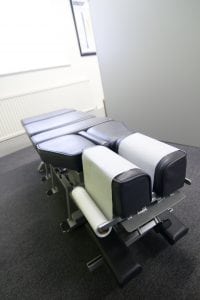Sciatica is a common condition which we treat here at Complete Chiropractic. Much like low back pain, sciatica is a condition which can range in intensity form a low grade ache to an acute and disabling pain. While many people do seek treatment of sciatica, many (usually those with the low grade pain!) often try to ignore the issue. Today however, there’s no need to ignore the problem – research shows that chiropractic is an effective treatment for sciatica!
What is Sciatica?
Simply put sciatica is the irritation or inflammation of the sciatic nerve. The sciatic nerve is the longest nerve in the body. It runs from the pelvis through the hip area and buttocks and then courses down the back of each leg. When this nerve is irritated or inflamed, the result is a pain that radiates along its course. Sciatica may feel like a leg cramp or as numbness, burning or a pins-and-needles sensation. Acute sciatic pain can be very intense, with many patients describing it as piercing or stabbing.
The causes are typically subluxation, a herniated disk or what is known as piriformis syndrome (learn more about that here)
The wrong way to treat Sciatica
There are three common (and wrong) ways to treat sciatica.
The first is to just ignore the issue, this obviously won’t work since it does nothing to address the underlying problem!
The second typical approach is bed rest. This approach might be recommended by some doctors and certainty seems to make sense at first glance – just rest the area and allow the inflammation to subside. Unfortunately research shows that approach is not effective – by way of example one study of 183 sciatica patients found that bed rest was no more effective than “watchful waiting.” After 12 weeks, patients who were assigned to bed rest had no more improvement than those who were in a “watchful waiting” group. Researchers concluded that there was “no evidence that bed rest is an effective treatment for sciatica.”[1]
Probably the most common approach today is trying to mask the pain with nonsteroidal anti-inflammatory drugs (NSAIDs) such as ibuprofen. Although these drugs may seem to pose little risk, overuse is linked to chronic headaches and migraines, gastrointestinal problems, heartburn and ulcers. While these medications can be effective in dealing with sciatic pain in the immediate term, they are not a long term solution and don’t do anything to address the underlying issue.
It’s not just common over the counter medicines which are sometimes prescribed for sciatica either. A recent study sought to explore weather Pregabalin, a drug which has been shown to be effective in the treatment of some types of neuropathic pain, might be effective in reducing sciatic pain.
The study, which offered half of its participant group (209 patients) Pregabalin and half a placebo, measured their pain scores for a total of 52 weeks. The researchers concluded that treatment with pregabalin did not significantly reduce the intensity of leg pain associated with sciatica and did not significantly improve other outcomes, as compared with placebo, over the course of 8 weeks. That being said, just as with over the counter medicines, the incidence of adverse effects was significantly higher in the pregabalin group than in the placebo group. Over the course of the study, there was a total of 227 reported side effects, of which dizziness was a common type. [2]
The right way to treat Sciatica
Unlike the above approach, manipulative therapies such as chiropractic care are a safe and effective way to treat sciatica without the risk of side effects.
Since 2014 it has also been known that a combination of manipulative therapy and a home exercise program is the most effective way to treat sciatica. A 2014 paper reported greater improvements in most patient-rated outcomes, including pain and disability, after 12 weeks of dual chiropractic and home exercise care. Patients treated with a dual approach report significantly reduced pain, use of medication, disability and most importantly show high satisfaction with their treatment.[3]
Thanks to a study published in late 2016[4] however, we now have more detail than ever on exactly what sciatica patients really value when it comes to their treatment. Following 174 patients through a 12-week course of treatment using either Spinal manipulation therapy (SMT) – A chiropractic adjustment – or Home exercise with advice (HEA) – or both, the study reveals some key information for chiropractors today.
Let’s look at some of the findings:
Finding number one – Patients value personal but professional interaction
It’s no surprise that when you’re suffering from a condition such as sciatica, it’s reassuring and supportive just to be able to speak to someone who understands your condition and can offer a reasonable treatment. At Complete Chiropractic, we believe in treating the patient first and the condition second. Unlike a GP, we have the time to get to know you as a person and to base your care on your personal situation and desired outcome.
Clearly, this approach is appreciated by patients, since of the 174 patients enrolled in the study, 120 cited the professionalism and personal interest of the staff as a major factor in their recovery.
One parent noted how:
“The professionalism really made a difference with me. Everybody was very professional, very knowledgeable. They do their job, and they showed genuine concern about how I felt.”
(Patient no. 10068 SMT & HEA)
Finding number two – Home exercise plans have a broader impact
When many of us her the term “home exercise program” we tend to sigh and moan – but the reality is that most targeted programs which we prescribe as part of sciatica treatment take less than 15 minutes a day, and certainly aren’t strenuous in the real sense.
Although the actual exercises used for sciatica treatment are quite simple and brief,the study showed that they can have a much greater impact than you might think. In fact, 63 of the patients commented on how just having something proactive to do to manage the pain was a real positive factor.
Going further though, 26 of the study participants actually discovered that doing the simple program helped them to build better exercise habits in their life.
One patient commented that “I think that it kind of gets you going in the morning and it just is good for your back. It’s good for you. And if I hadn’t come here, I wouldn’t have been doing them.”
(Patient no 10235 HEA)
Finding number three – Chiropractic gets fast results
While having a way to take control and manage pain between adjustments was valued by many of the participants, for 60 of them, the feeling of immediate relief provided by a chiropractic adjustment was the best part – one commented: “I always felt really good right after being adjusted!”
For 51 of the participants, there as nothing at all about the chiropractic care which they did not enjoy – in fact, most of the negative comments about the chiropractic care related to the difficulty in travelling to the practice or in arranging appointments.
This might seem a trivial point, but there no question that difficult in accessing care can be a major factor for some! At Complete Chiropractic, we have free on-site parking for those travelling by car, but were also located just 5 minutes walk from Chelmsford railway station and sit directly opposite the King Edward school bus stop for those who would rather take public transport.
Find number four – Taking control of sciatica is well worthwhile
Humans can get used to living with almost anything, so for many people suffering from non-acute sciatica, a gradual acceptance of the pain and the attitude that “this is just my life now” can creep in. The study results are clear however, treating sciatica and ending the pain is certainly worthwhile!
152 of the study participants felt that their care had been totally worthwhile, while the majority of the rest felt that at least part of their care had been worth it.
“It took away my pain. It gave me back a life. When you’re in pain so much of the time, it affects your whole… everything. I have a new outlook on life now.”
(Patient no 13091 SMT & HEA)
“… It helped me to exchange and hear a doctor’s opinion, a doctor who has a lot of experience with what I am going through. So it was so precious to me to get the feedback. And, realistically hear what the outcome could be or what can be done, what cannot be done. It was the exchange that I got.”
(Patient no 13979 SMT & HEA)
“[I learned] how to handle myself better… how to work my body better so I’m not causing my body more discomfort”
(Patient no 13619 SMT & HEA)
“It’s added more quality to my life… I’m even happier!”
(Patient no 10258 HEA)
“It gave me back a normal life. When you’re in pain so much of the time… your whole outlook is down. It’s like I have a new outlook on life now.”
(Patient no 13091 SMT & HEA)
Don’t wait, treat Sciatica today!
Throughout January, we’re offering an amazing new patient special deal – if you’re suffering from sciatica, book an appointment today and learn how we can help you beat sciatic pain for good!

[1] New England Med J 1999:340:4 18
[2] New England J Med 2017; 376:1111-1120
[3] Bronfort et al. Spinal manipulation and home exercise with advice for subacute and chronic back-related leg pain: a trial with adaptive allocation. Ann Intern Med. 2014 Sep 16;161(6):381-91. doi: 10.7326/M14-0006.
[4] Michele J Maiers et al. What Do Patients Value About Spinal Manipulation and Home Exercise for Back-related Leg Pain? A Qualitative Study Within a Controlled Clinical Trial Man Ther. 2016 (Dec); 26: 183–191


